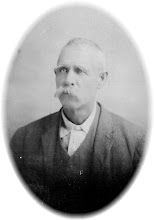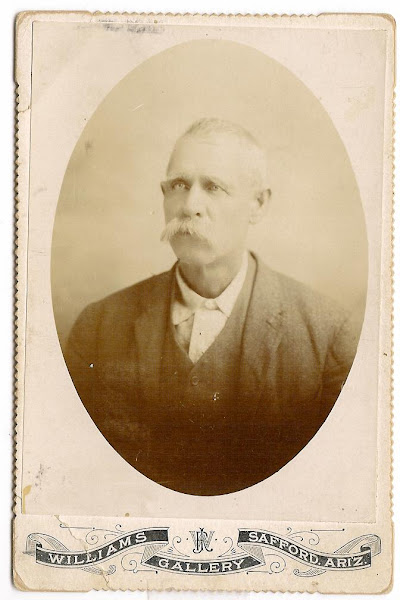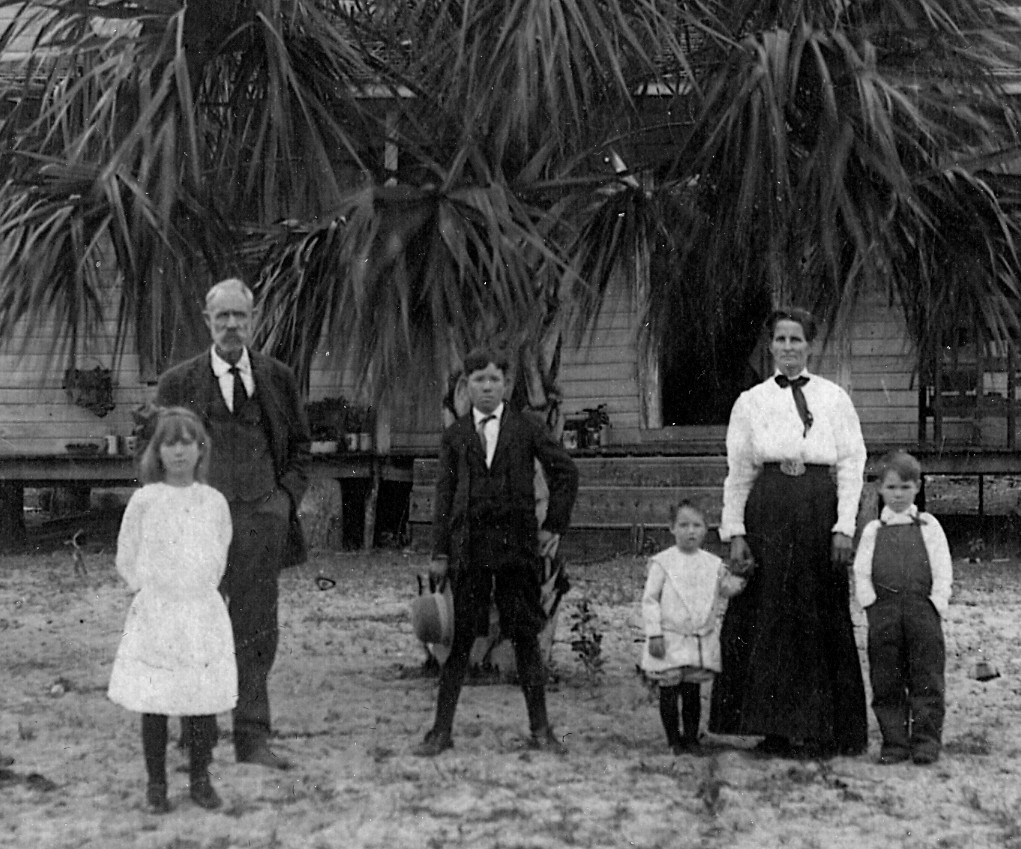Thursday, March 27
Identities of McGrath Portrait [see below]
Joe [Milton Alonzo] McGrath has provided the identities for this picture. He wrote:
"The original of this photo obviously had some incorrect identifications written on the back of it. The picture was taken about 1903 or 1904. We know this by the dates of Uncle Frank's mission to Mississippi. He returned home and lived with the family for a period of time. My sister, Faye, and I have researched this a lot and feel comfortable with our identifications.
The picture has 3 groups: Some children of James Alonzo and Delilah Stewart, Some children of Arminda Alice and William Asay, and a child of James Alonzo and Arminda Alice.
James Alonzo and Delilah had 11 children together and 8 of them are in the picture. Missing are Nancy ( who was married), Jesse(who died in 1890), and Robert(who died as an infant and was buried near Taylor but his grave is now lost).
Arminda Alice and William Asay had 5 children, 2 boys and 3 girls. The 2 boys died as youths. Two of the girls are in the picture, Anna and Millie. Mabel was staying with her Hendricks grandparents and thus not in the picture.
James Alonzo and Arminda Alice had 4 children together but only one was born at the time this picture was made. The baby in the picture is Richard, their firstborn(1902)
The people are as follows:
Back row from left to right: Alexander, Mary, Joe, Anna Asay, and Martha Oliver.
Middle row from left to right: Frank, Belle, James Alonzo, Bertha, Arminda Alice. Grandmother Alice is pregnant with Rose and one can see that in the original picture.
Front row from left to right: Millie Asay, George, Gene, and above mentioned Richard.
I would be happy to discuss our research with anyone that is interested."
Signature
Wednesday, March 26
Warranty Deed from Greenlee County, Arizona
from Lorenzo Hatch history
Tuesday, March 25
Number of Families in Wagon Train
"In 1875, missionaries baptized nearly 90 people in the Des Arc area "many of the best citizens of the region," it was reported. In 1877, the Des Arc congregations moved approximately 27 families and 125 people to Utah by wagon. Persecution was rampant against early Church members, thus many traveled west."
Monday, March 24
Henry Green Boyle 1824-1902
In Need of Water at Agua Frio
[from Nettie Hunt's diary]
“When Father received word they would pass through Sevoia Valley where we lived, and when we heard they were nearing our place, he was strongly impressed to go meet them. So taking his team and outfit he went, taking our eight-year-old brother John, whose birthday it was, with him. They drove fifty miles before meeting the emigrants at Agua Frio, a Mexican ranch named for the large, cold spring there. On arriving, he found about twenty families, with more than 100 head of animals. Father’s going to meet them was simply an act of courtesy on his part, for he did not know they would be needing him so badly. The emigrants had made a long drive without water and had been told they could get plenty of water at Agua Frio. But when they arrived there, the Mexicans who claimed the water would not let them water a single animal unless they paid a big price. These poor Southern people who had been on the way more than three months, did not have the money to pay for water; besides, Father felt it was an imposition for them to have to pay when there was a great plenty of water, and the animals were already choking and could not go to the next water.
“The Southern people could not speak a word of Spanish, and the Mexicans could not speak a word of English. They were having a hard time, for the Mexicans were guarding the tank, which was filled from the large spring. This was the dilemma Father found the converts in, and they were feeling very downhearted and discouraged, but when they found Father could speak Spanish fluently and was there to champion their cause, their spirits rose immediately. Father very patiently explained all the conditions to the Mexicans and showed them that the animals must have water, that the emigrants had no money to pay for it, and that it would be no hardship to the owners, as they had an inexhaustible supply. There was a good deal of arguing pro and con, which Father saw was not getting him anywhere, so he rose to the occasion, as he well knew how to do, and producing his pistol, which was his constant companion in those early and dangerous days, he told them there was one thing they were going to have—they were either going to have water, or they were going to have blood—and he would leave it to them to say which it should be. When the Mexicans saw they were outwitted, as well as far outnumbered, they very grudgingly allowed the animals to be watered. This is the way Father put it: ‘When they saw I really meant business, they came through…’
“There was a real stir of excitement when it was learned that so many people were coming into our beautiful little valley that boasted only about a half dozen families. However, they had been there but a short time when President Lot Smith of the Little Colorado Stake sent teams, wagons, and provisions to help the converts on down to the settlements on the Little Colorado River in Arizona [November, 1877]. There were about half a dozen families who had quite enough traveling for awhile and wished to go no further, so remained in Sevoia. We were delighted that they chose to do this, for our increased numbers took away much of the loneliness of life in this isolated place.”
Those who remained were the Brown, McGrath, Wamsley, West and William Talley families. They stayed three years.
Persecutions that led West
The reason for the trip:
After joining the church many new converts were met with severe opposition:
William Talley, wrote: “The persecution had become so bad that we decided to come West … We sold our farm Apr 1 … The persecution was so great that many had to leave their homes at night … Two weeks later we were ready to start … There were 36 wagons in all.”
The company was led by Nelson C. Bebee. Later, he fell ill and turned the lead over to Elder Wimmer.
Heartbreak
[quoting from Nettie Hunt's diary in the "History of Ramah Pioneers by Gary Tietjen]
“At the time of this incident, Alonzo McGrath and his wife, Nancy McGrath, and two small sons were living in this house. Sister McGrath was very ill with smallpox and suffering as one does with that terrible disease. Members of our family had been assisting in every way they could, and this night Father said we could not leave them alone, when Sister McGrath was so very ill, and told our Sister May he wished she would go and stay with them until midnight, then come home, and he would go stay the rest of the night. Our family was all sleeping when, at eleven o’clock, May came home. Father was awake at once and asked why she came home so early; she answered, ‘Sister McGrath seems to be out of pain and is having a nice sleep. Brother McGrath is sitting in a chair by the fireplace dozing. He says he is going to sit there until morning, and that I might as well come home.’
“May went to bed, and Father was just dozing off to sleep, when he heard his name spoken, ‘John.’ He was awake at once; then the voice said, ‘John, Sister McGrath is dead.’ Father dressed hurriedly and went to the McGrath home. He entered quietly. Brother McGrath awakened. Father inquired how his wife was. He answered, ‘She has seemed to be free from pain for quite awhile and is having a nice sleep.’ Father went to the bed, turned back the covers, and found that the dear little mother was indeed asleep, the last long sleep of death. She had been dead for several hours. It would have been sad indeed if the poor heart‑broken husband had been alone when he discovered that his dear young wife had really passed away.
“Most of the time while Sister McGrath had been ill, our mother, Lois Pratt Hunt, had cared for the two children, usually in our home. They both had smallpox, the youngest one a bad case. He seemed to be much better, until the mother died; then he suddenly became worse and soon passed away. Kind neighbors made a coffin, lined it with a sheet, and the mother, with her precious baby beside her, was placed in it. A foot and a half of snow had to be removed before a grave could be dug.”
note: Children were not two boys but a boy and girl.
Sunday, March 23
James Alonzo McGrath, Conversion to Church & Move West
"When Uncle Alonzo was twenty years of age he married Nancy Warnick of Carrol County, Georgia and this was where Pa and Mama's farm and house were located out in the country. Then Uncle Alonzo, with his new wife and his mother [Aunt Martha], moved to Alabama. It seems that Pa and Mama must have sold their home in Georgia and moved to Alabama about this time also, due to the facts taken from Uncle Alonzo's history sketch, as they were all there together when they met the Mormon missionaries and gained their lasting testimony of the Gospel. Then the persecution became so bad from their families and those whom they thought were their friends that they decided to leave, as word came to them by traveling missionaries that a company of Saints were being organized in Arkansas to go to Arizona the following spring.
Three of the families who lived there- namely Pa and Mama with their son, Jim, Uncle Alonzo and his wife with Aunt Martha, and another family of converts, Alexander Stewart, who lived there. They decided to sell all they had and equip themselves with teams and wagons and join the company in Arkansas for the trip to Arizona the following spring. They moved immediately to the Ozark Mountains, Clay county, Arkansas and spent the winter.
They left for Arizona about April, 1877."
Jesse Jackson Brady Family Portrait
James Alonzo McGrath and Uncle Jesse Brady
"About 1858, previous to the Civil War, Aunt Martha McGrath, Mama's sister had been left a widow with one small son. She was living in Atlanta, Georgia at the time- his name was Alonzo- and as she had no means of taking care of him and Pa and Mama had no children and were living out in the country, she sent him to live with them. They raised him as their own until he was eighteen years of age. He was six years old when they took him. When he was eighteen he went back to live with his mother in Atlanta. Years later and after us children came along, we always called him Uncle Alonzo, so when I mention him later you will know that he was Mama's nephew."







